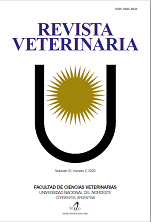Eficacia del timol sobre Varroa sp y Nosema sp en colmenas utilizadas para fecundación en México
DOI:
https://doi.org/10.30972/vet.3124747Palavras-chave:
abejas, patógenos, timol, varricida, nosemicida, prevalenciaResumo
Actualmente existe la necesidad de utilizar productos alternativos de origen natural que no afecten negativamente la productividad de las colmenas y que reduzcan la presencia de diversos patógenos. El timol es considerado como el producto natural más utilizado para el tratamiento de la varroasis en todo el mundo y potencialmente eficaz como nosemicida. Por lo tanto, el objetivo de esta investigación fue estudiar el impacto del timol sobre el control de la varroasis y nosemosis en colmenas para la formación de núcleos de fecundación de abejas reina (Apis mellifera). Se utilizaron 65 colmenas en las cuales se cuantificó el nivel de infestación para Varroa, nivel de infección para Nosema y las prevalencias de ambas enfermedades en la población antes y después del tratamiento, basado en 4 aplicaciones de timol al 20% en azúcar glass con intervalo de 7 días. La prevalencia de la varroasis disminuyó al igual que el nivel de infestación post tratamiento (p<0,05). Por el contrario, la prevalencia de la nosemosis (p>0,05) y el nivel de infección de Nosema fueron mayores después del tratamiento (p<0,05). Se concluye que en las colmenas para la formación de núcleos de fecundación de abejas reina, el timol es eficaz contra varroasis pero no contra nosemosis.Downloads
Referências
Adamczyk S et al. 2005. Evaluation of residues of essen- tial oil components in honey after different anti-Varroa treatments. JAgric Food Chem 53: 10085-10090.
Alaux C et al. 2010. Interactions between Nosema micro- spores and a neonicotinoid weaken honey bees (Apis mel- lifera). EnvironMicrobiol 12: 774-782.
Amiri E, Strand MK, Rueppell O, Tarpy DR. 2017. Queen quality and the impact of honey bee diseases on queen health: potential for interactions between two major threats to colony health. Insects 8: 48.
Bulacio CN, Basualdo M, Eguaras M. 2010. Actividad varroacida del timol en colonias de Apis mellifera de la Provincia de Santa Fe. In Vet 12: 85-90.
Cantwell GE. 1970. Standard methods for counting Nosema spores. Amer Bee J 110: 222-223.
Conte Y, Ellis M, Ritter W. 2010. Varroa mites and honey bee health: can Varroa explain part of the colony losses? Apidologie 41: 353-363.
Costa C, Lodesani M, Maistrello L. 2010. Effect of thy- mol and resveratrol administered with candy or syrup on the development of Nosema ceranae and on the longevity of honeybees in laboratory conditions. Apidologie 41: 141150.
Dejong D, Dejong P, Goncalves L. 1982. Weight loss and other damage to developing worker honeybees from infes- tation with Varroa jacobsoni. JApicult Res 21: 165-167.
Espinosa LG, Guzmán E. 2007. Effectiveness of two natural miticides, formic acid and thymol, for control of the mite Varroa destructor in honey bees (Apis mellifera) in Villa Guerrero, Mexico. VetMexico 38: 9-19.
Fernández EA, Zavala HJ, Romero CR. 2010. Atlas climático digital de México. Centro de Ciencias de la Atmósfera, UNAM. Available online: http://atlasclimatico. unam. mx/atlas/kml.
Floris I, Satta A, Cabras P, Garau VL, Angioni A. 2004. Comparison between two thymol formulations in the control of Varroa destructor: effectiveness, persistence, and residues. JEconom Entomol 97: 187-191.
Heeve JP et al. 2016. Evaluation of Fumagilin-B and other potential alternative chemotherapies against Nosema cer- anae-infected honeybees (Apis mellifera) in cage trial as- says. Apidologie 47: 617-630.
Higes M et al. 2008. Detection of infective Nosema cera- nae (Microsporidia) spores in corbicular pollen of forager honeybees. J Invertebr Pathol 97: 76-78.
Imdorf A, Bogdanov S, Kilchenmann V. Maquelin C. 1995. Apilife var: a new varroacide with thymol as the main ingredient. Bee World76: 77-83.
Juven B, Kanner J, Schved F, Weisslowicz H. 1994. Fac- tors that interact with the antibacterial action of thyme es- sential oil and its active constituents. JApplMicrobiol 76: 626-631.
Llorente J, Higes M, Suárez M. 1996. Actas del II Congreso de la Sociedad Española de Agricultura Ecológica, Pamplona: orgprints.org/29757/l/actas-pamplona-vd.pdf.
Mahmoud AL. 1999. Inhibition of growth and aflatoxin biosynthesis of Aspergillus flavus by extracts of some egyptian plants. Letters Appl Microbiol 29: 334-336.
Maistrello L et al. 2008. Screening of natural compounds for the control of Nosema disease in honeybees (Apis mel- lifera). Apidologie 39: 436-445.
Montano L, Guzman NE. 2007. Effectiveness of two natural miticides, formia acid and thymol, for control of the mite Varroa destructor in honey bees (Apis mellifera) in Villa Guerrero, Mexico. Vet Mexico 38: 9.
Moreno AA, López MS, Corcho BA. 2000. Principales medidas en epidemiología. SaludPúblMéx 42: 337-348.
Ravoet J et al. 2013. Comprehensive bee pathogen screen- ing in Belgium reveals Crithidia mellificae as a new con- tributory factor to winter mortality. PLoS One 8: e72443.
Reyes FR. 2016. Efectividad de cuatro acaricidas en el control del ácaro (Varroa destructor) en abejas. http://re- positorio.lamolina.edu.pe/handle/UNALM/2755.
Rice RN. 2001. Nosema disease in honeybees. Genetic variation and control (Australian Report). Res & Develop Corp 1: 46.
SPSS Inc. 1999. Statistical package for the social sciences. Chicago, Illinois, USA. https://www.academia.edu.
Unión Europea Diario Oficial. 2007. Regl. Unión Europea N° 834/2007. https://eur-lex.europa.eu/legal-content/ es/TXT/?uri= CELEX:32007R0834.
Viollon C, Chaumont JP. 1994. Antifungal properties of essential oils and their main components upon Cryptococ- cus neoformans. Mycopathologia 128: 151-153.
Williams BA. 2009. Unique physiology of host-parasite interactions in micros- poridia infections. Cellular Microbiol 11: 1551-1560.
Williams GR., Shutler D, Burgher KL, Rogers RE. 2014. Infra-population and community dynamics of the parasites Nosema apis and Nosema ceranae, and conse- quences for honey bee (Apis mellifera) hosts. PLoS One 9: e99465.
Downloads
Publicado
Como Citar
Edição
Seção
Licença
Política de acceso abierto
Esta revista proporciona un acceso abierto inmediato a su contenido, basado en el principio de que ofrecer al público un acceso libre a las investigaciones ayuda a un mayor intercambio global de conocimiento. La publicación por parte de terceros será autorizada por Revista Veterinaria toda vez que se la reconozca debidamente y en forma explícita como lugar de publicación del original.
Esta obra está bajo una licencia de Creative Commons Reconocimiento-NoComercial 4.0 Internacional (CC BY-NC 4.0)










.jpg)
.jpg)



